Arts Integration: Semiotic
Transmediation in the Classroom
by J. David Betts,
Ph.D., Adjunct Assistant Professor,
University of Arizona
Paul Fisher, Director of Arts
Education,
Tucson , AZ.
Sandy Jean Hicks, Ph.D., Assistant
Professor,
University of Rhode Island.
ABSTRACT
This study describes two years of
research with the Arts Integration Program (AIP) of the Tucson Pima Arts
Council, Tucson, AZ. AIP supports teachers in integrating fine arts activities
into their classroom. AIP provides lesson outlines and demonstration lessons
by arts specialists in music, dance, theatre arts and visual arts. The
initial phase of the study looked at the ability of the lesson outlines
to successfully deliver curriculum content and change student attitudes
and perceived self-efficacy. Fourth graders showed short term gains in
core curriculum taught throught AIP. Teachers were very responsive to the
new lesson ideas. The second phase of the study was an in-depth look at
the implementation of a year-long Mentor-teacher process for promulgating
AIP in theatre arts and creative dramatics in the classroom. Teachers with
one year's experience with AIP were teamed with teachers new to the program.
Teacher journals, classroom observations, interviews and videotapes were
analyzed. This data showed how such a program can work to bring transmediational
experiences for the children into the generalist teacher's classroom as
they learn to make meaning in a variety of sign systems. The Mentor-teacher
process is shown to be an effective way to make the most of outside arts
resources.*
In 1990, one of the authors (Fisher),
as director of Arts Education of the Tucson Pima Arts Council (TPAC), developed
a program of integrated theatre arts lessons for grades K-8. These lesson
outlines have been used and evaluated for five years in over 75 schools
in southern Arizona as a part of the Arts Integration Program (AIP). AIP
also offers similar programs in music, dance, and visual arts.
The theatre arts lessons are developmental,
that is, they first introduce a
vocabulary of drama techniques,
such as facial and vocal expression, mime, and improvisation, then they
demonstrate how those skills can be integrated into the curriculum, be
it language arts, social studies, or other core curriculum. They are also
adaptable within the K-8 age range. The value of these activities has been
demonstrated by five years of teacher evaluations and several years of
research and assessment.
AIP is, fundamentally, a program
supporting generalist teachers who are interested in using the arts in
their classroom. AIP provides workshops, demonstrations by arts specialists,
ongoing support, and consultation. Many teachers are responding to the
current published research in sociosemiotics: that we utilize an array
of negotiated sign systems to express and make meaning (Suhor, 1992; Berghoff,
1993), for example. Gardner's (1991) concept of multiple intelligences
is also having an impact in the classroom. Bruner (1991) writes that we
have developed "tool kits", which allow us to make meaning in many different
media. The AIP Theater Arts lessons provide ways for teachers to bring
these theories into practice in their classrooms.
Eisner (1994) suggests that schools
teach "forms of representation [art, music, dance, poetry, literary text,
mathematics, science, etc.] . . . each carries with it its own parameters
of possibility for the construction and recovery of meaning." (p.88) Each
form is subject to "different modes of treatment ," i.e., language can
be literal or literary, music can be mimetic or expressive. And, ". . .
each form of representation can be variably located on a syntactical structure.
. . from rule-governed to figurative." (p.88) Eisner holds that children
who have these educational experiences will be better able to make sense
of their environment.
Many educators are concerned about
having to develop new means of assessment in response to these new learning
paradigms. Mastery of new mediational means, or sign systems, as tools
can be assessed by the learners increased "ability to participate in qualitatively
new collaborative activities" (Moll, 1990. p.13). Theatre arts, for example,
encourages children to bring their own knowledge of the physical and social
world into the classroom. In a Vygotskian sense making them aware of how
they are "manipulating the literary process and applying this to reorganizing
future experience or activity." (Moll, 1990. p.13)
AIP teachers engage their students
in fine arts activities that can be tailored to curriculum goals. Arts
experts work in the classroom, introducing ideas and techniques. The children
learn in an environment that encourages and values their aesthetic responses
to new knowledge.
AIP begins by acknowledging that
the child perceives information in an emotional context. The manipulation
of art materials and media from several sign systems allow the child to
actively construct knowledge. This brings together core curriculum matter
and socio-historical development. The children use the information and
come to process it in their own terms. AIP also acknowledges a reciprocal
engagement of the teacher and pupils, each having an effect on the other
as art skills and confidence grow. Teachers use and adapt the AIP activities
to build constructive classroom learning environments. Teachers and students
create in the classroom much as artists utilize the resources of their
studios.
Initial Study (AIP I)
In 1992 we received a grant to determine
whether the assumptions made about the program at that time were correct.
Our first study asked: Did the children pick up the imbedded core curriculum
material? What was the effect on the students and on the classroom learning
environment? And, How did teachers feel using the Arts Integration Program
lessons for the first time? This research, to measure the effects of the
Arts Integration Program on learning, was supported by the Arizona Arts
Education Research Institute and the Tucson Pima Arts Council. Four teachers
were selected to participate in the program for the first time. Their one
hundred fourth graders were tested on lesson concepts before and after
each of eight AIP lessons during one semester. The learning objectives
were in math, social studies, history, science and language arts. The lessons
were chosen from the most highly rated Arts Integration Program lessons
in dance, theatre, music and visual arts based on responses from teachers
who had used the lessons for two years.
A student questionnaire was used,
as well as content tests, observations, teacher interviews and journals,
to describe the effects of the program. The Perceived Self-Efficacy, Attitude,
and Linguistic Domain questionnaire (Betts & Hicks, 1994) was devised
to look at change in how students felt about art, about school, and about
themselves. The questions were analyzed in three categories:
1. The student's belief in their
own abilities, both artistic and scholastic: their perceived self-efficacy.
How competent a musician or math student did they think they were?
2. The student's liking or disliking
of school and art activities. For example, how did they feel when it was
time for visual arts? or social studies?
3. The language they used to describe
the arts and why they think it is important to learn about the arts. What
was their linguistic domain for art and its place in learning?
The questionnaires were administered
at the beginning and end of the Arts Integration Program semester. Those
results were compared to that of similar groups of fourth graders in another,
non-participating, class which fell in the mid-range of most of the experimental
classes determiners: ITBS scores, SES, demography, etc. This class had
no arts integration program outside their curriculum.
In the experimental classrooms several
aspects of the learning environment were recorded. Teachers were observed
during the semester and interviewed at the beginning and end. How did they
feel about doing arts activities? What was their preparation in the arts?
Did they see school art as basic or ancillary to the process of education?
The participating teachers were new program volunteers. Their interviews
before and after the program showed a pattern of change related to the
experience.
Content tests
What we learned from the first study
is that the kids "got", or assimilated, the intended information through
the Arts Integration Program activities in the short term of this study.
Their test scores went up almost universally after the lessons.
Table 1, below, shows the results
of the Content Area Tests for each target lesson for each class. The total
percentage of right and wrong answers on the pretest and the posttest for
all classes on all lessons is shown at the bottom. Class 2 did not use
the lesson outline entitled Instruments. Children who participated performed
consistently better on the posttests. For example, on the Energy lesson,
an increase of 36% in right answers over all classes was measured.
Table 1. AIP I: Content Test Scores
Lesson
|
Class
|
Pretest wrong
|
Pretest right
|
Posttest wrong
|
Posttest right
|
Mayan Math
|
1
|
224
|
36
|
117
|
147
|
|
2
|
196
|
21
|
112
|
102
|
|
3
|
158
|
50
|
98
|
120
|
|
4
|
246
|
23
|
163
|
86
|
Instruments
|
1
|
141
|
75
|
42
|
117
|
|
2
|
0
|
0
|
0
|
0
|
|
3
|
126
|
50
|
93
|
80
|
|
4
|
178
|
37
|
115
|
69
|
Say It Like...
|
1
|
84
|
55
|
52
|
86
|
|
2
|
70
|
40
|
19
|
76
|
|
3
|
41
|
68
|
29
|
75
|
|
4
|
54
|
71
|
58
|
62
|
Parent/Child
|
1
|
38
|
82
|
31
|
81
|
|
2
|
62
|
47
|
36
|
77
|
|
3
|
36
|
68
|
14
|
87
|
|
4
|
61
|
66
|
37
|
93
|
Sculpture
|
1
|
66
|
88
|
11
|
129
|
|
2
|
57
|
75
|
11
|
121
|
|
3
|
39
|
87
|
30
|
93
|
|
4
|
50
|
88
|
9
|
145
|
Heraldry
|
1
|
111
|
18
|
24
|
110
|
|
2
|
84
|
31
|
23
|
81
|
|
3
|
93
|
22
|
19
|
82
|
|
4
|
125
|
5
|
71
|
108
|
Gravity
|
1
|
97
|
76
|
55
|
106
|
|
2
|
73
|
59
|
39
|
93
|
|
3
|
68
|
58
|
35
|
91
|
|
4
|
99
|
51
|
28
|
116
|
Energy
|
1
|
105
|
91
|
36
|
90
|
|
2
|
99
|
62
|
19
|
135
|
|
3
|
75
|
71
|
47
|
100
|
|
4
|
118
|
63
|
51
|
117
|
Average
|
96
|
55
|
46
|
96
|
Percentage
|
64%
|
36%
|
32%
|
68%
|
Perceived Self-efficacy and Attitude
Although the initial one-semester-long
treatment did not make either significant change or difference for most
of the items on the questionnaire for most classes compared to the control
group, there were indications that interest in school in general was significantly
sustained in the experimental classes compared to the control group. Four
areas addressed in the questionnaire were:
1. Students' perceptions of the
value of learning about the arts.
2. How much they had learned in
school about the arts,
3. How much they expected to learn
about the arts outside of school.
4. Students' attitudes toward dance
and visual arts.
On each of these items there was
a treatment interaction: the control group began with more positive scores
but did not maintain them over the semester, while one or more of the experimental
classes began with lower scores on those items and those scores surpassed
the control group score on the posttest.
There was a significant interaction
effect for Class 1 on Question 7: Interaction effect: F (1,42) = 4.04,
p < .05. (see Figure 1, below) The control group initially believed
that it was more important for a person to know about the arts than the
experimental group. However, by the end of the study the reverse was true,
the experimental group believed it was more important for a person to learn
about the arts than the control group.
Figure 1. AIP I: Question 7: How
important is it for a person to know about the arts?
Control
(n=24) Mean
SD
SE
|
Pretest
4.16
1.01
.23
|
Posttest
3.89
.88
.20
|
Experimental 1
(n=29) Mean
|
3.64
1.08
.22
|
4.24
.78
.16
|
|
DF
|
Sum of Squares
|
Mean Square
|
F-Value
|
P-Value
|
Group
|
1
|
.16
|
.16
|
.21
|
.6522
|
ERROR
|
42
|
32.79
|
.78
|
|
|
Repeated Meas.
|
1
|
1.14
|
1.14
|
1.14
|
.2916
|
Interaction
|
1
|
4.02
|
4.02
|
4.04
|
.0510
|
ERROR
|
42
|
41.84
|
1.00
|
|
|
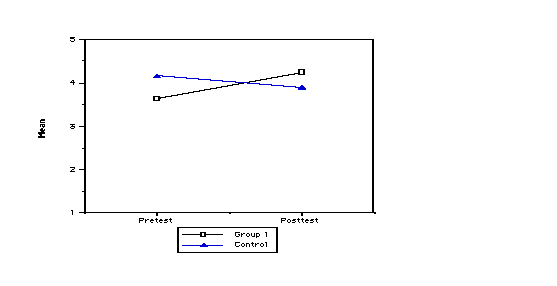
All four experimental classes showed
an interaction effect on question 12, "How much do you expect to learn
about the arts outside of school?" The control group had lowered expectations
over the course of the semester about how much they would learn about art
once school was over and the children in the experimental classes reported
that their expectations had increased during the semester.
By the end of the study, the experimental
students reported that they expected to learn more and had improved attitudes
about school and about art and better perceptions of self-efficacy, although
the majority of the differences were not statistically significant. Data
indicated that there were no significant differences between the groups
with the exception of the interactions discussed above. This was perhaps
due to the limited intervention in one semester that made up this initial
study.
Linguistic Domain
The language the children used to
define the arts and discuss its importance showed noticeable change over
the semester. Analysis showed a decrease in career-related language and
an increase in academic and cognitive terms that showed students' awareness
of their own learning processes.
A linguistic domain is the expression
of a group's culture, knowledge and interests. The linguistic domain of
each classroom was examined in relation to the arts because it contains
the seeds of new knowledge gained. It may also indicate change in the children's
linguistic environment related to their experience of the Arts Integration
Program.
Data for the linguistic domain analysis
was gathered in two ways. First, to get a picture of the children's linguistic
domain relating to art they were asked at the beginning of the questionnaire
to answer the question, "What are the arts?"
This is the only question on the
first page of the Perceived Self-efficacy, Attitude, and Linguistic Domain
Questionnaire. The protocol called for the questionnaire to be administered
with as little discussion as possible before the students were finished.
In this way it was hoped to minimize the effect of the language of the
rest of the questions on the children's responses.
The responses of each child were
compared for change in the character of the words used. The change each
class showed over the course of the Arts Integration Program reflects the
students' new construction of meaning. Responses to this question showed
not only some predictable language use, but also revealed some interesting
associations and change in word use.
The children's responses were coded
in the six categories:
1. Affect: "Pretty things I like."
2. Self: "When I draw"
3. Activity/process: "Drawing and
painting."
4. Other individuals: "Picasso"
5. Object/thing: "A painting."
6. Subject: "Art class"
The seventy-eight students in the participating
classes who filled in both the pre- and post- semester questionnaires showed
a strong initial tendency to define art as an activity or process (e.g.,
drawing, learning). Totals in this category increased over the semester.
Table 2, below, shows the results of this question. Class 1 showed a strong,
almost 50%, gain by the posttest. Conversely, these classes showed a lessening
tendency to classify the arts as objects (e.g., paintings). The following
chart shows the distribution of responses to question One. Class 5 is the
comparison class, which did not use the Arts Integration Program lesson
outlines. The last column is a total for the experimental classes 1-4.
Table 2, AIP I: Question One. What
are the Arts?
Pretest and Posttest Results
|
Class 1
|
Class 2
|
Class 3
|
Class 4
|
Class 5
|
Total 1-4
|
|
pre-post
|
pre-post
|
pre-post
|
pre-post
|
pre-post
|
pre-post
|
Affect
|
2 0
|
2 2
|
4 0
|
3 0
|
1 0
|
11 2
|
Self
|
0 0
|
0 1
|
0 0
|
1 0
|
1 0
|
1 1
|
Activity
|
9 17
|
7 8
|
10 10
|
5 5
|
8 8
|
31 40
|
Others
|
1 1
|
1 1
|
0 2
|
0 1
|
1 1
|
2 5
|
Object
|
7 2
|
7 5
|
5 2
|
8 5
|
5 6
|
27 14
|
Subject
|
4 3
|
0 0
|
0 5
|
2 8
|
0 1
|
6 16
|
The second approach to the children's
linguistic domain involved a group activity. The last question on the questionnaire
was a brainstorming exercise for the whole class. Breaking up into small
groups, the students were asked to brainstorm their ideas about why it
is important for them to learn about the arts. This was done in order to
survey the groupsí attitudes about this question in a social collaborative
process of working together and sharing ideas. Each group listed their
ideas on posters. Each individual then selected from those lists the ideas
they thought most appropriate. The ideas recorded by the students were
categorized as follows:
1. Academic--learning about art
would help in a school subject, such as science.
2. Cognitive--learning about art
would help in acquiring a cognitive skill such as reading.
3. Meta-cognitive--it would help
in being able to think about learning.
4. Direct application--it would
help in doing art things.
5. Career--learning about art would
help in getting a job.
6. Affective--learning about art
would increase their enjoyment or change their behavior.
7. Not applicable--items not related
to the task.
Children used words to describe the
importance of learning about the arts selected from lists that they generated
in a small group brainstorming activity. Children showed an initial tendency
to use words related to the idea of careers, such as, "So you can be a
writer." ". . . [be] a clothes designer." ". . . be an artist." "To be
on television." And, "To choose your own career." Few children made academic
associations. However, there were many responses in the cognitive, direct
application, and affective categories. Very few made meta-cognitive associations.
Figures 2 & 3, below, show the
changes that occurred in total responses over the semester for all the
experimental classes and the control group as they collaborated and reflected
and finally chose those reasons why it is important to learn about the
arts.
Figure 2. AIP I: Why is it important
to learn about the arts?
Pretest Results
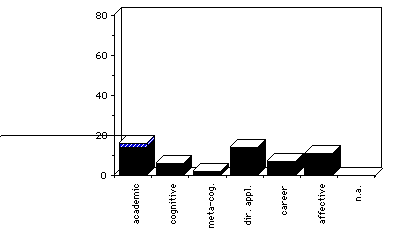
Figure 3. AIP I: Why is it important
to learn about the arts?
Posttest Results
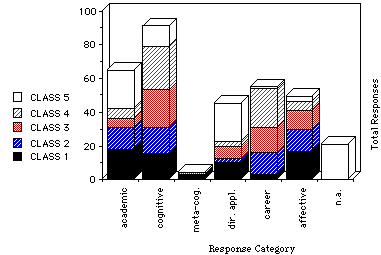 Although there were changes that were
specific to individual class groups, two noticeable global changes took
place over the course of the intervention. A comparison of Figures 2 and
3, above, shows that the number of ideas or responses categorized as academic
and cognitive each shows a large overall increase, while the number of
brainstorming ideas related to the career category declined.
Although there were changes that were
specific to individual class groups, two noticeable global changes took
place over the course of the intervention. A comparison of Figures 2 and
3, above, shows that the number of ideas or responses categorized as academic
and cognitive each shows a large overall increase, while the number of
brainstorming ideas related to the career category declined.
Teacher response
The most important focus of the
Arts Integration Program was on the teachers. They were co-investigators
in this inquiry. Structured interviews lasting an average of about 30 minutes
each were conducted at the beginning and end of the semester. These were
recorded and transcribed. Teachers were asked about their experience and
training, their subject preferences, and their outside interests. In particular,
they were asked about their experience in the arts. They were also asked
about their perceived self-efficacy in the arts and in academic subject
areas. Follow-up interviews were videotaped. Probes, based on the initial
responses, showed changes in attitude or self-efficacy on the part of the
teachers that might be associated with their AIP experience. Individual
differences between the teachers would have an effect on how the Arts Integration
Program curriculum materials were presented because each teacher facilitated
learning in his or her own way.
The length of experience and professional
development varied from no experience to over 12 years. Personal relationships
to the arts were different for each teacher. Some saw it as a form of relaxation,
some as an important activity for personal growth. Each had a different
experience with art and a different degree of perceived self-efficacy with
regard to art. These initial teacher differences may have had an important
effect on the outcomes of this study. Some had arts training in their background
and personal interest and experience in an arts discipline. Others had
very little experience in the arts beyond appreciation and interest in
how art might help them in the classroom. This group of teachers were most
confident in their abilities to teach math, science, and social studies.
These results are summarized in
Figure 4 below.
Figure 4. AIP I: Final Teacher Interviews
Teacher (School)
|
Years Exp.
|
Areas of strength
|
Arts interest
|
Needed support
|
AIP Experience
|
1
(A)
|
10+ years
|
music & drama
|
painting & music
|
dance, science
|
"Gained confidence."
|
2
(B)
|
none
(1st year)
|
math & science
|
photography & architecture
|
language arts, English
|
"Learned not to be so rigid."
|
3
(C)
|
12 years
|
math & reading
|
crafts & music
|
math
|
"...saw ways to integrate."
|
4
(D)
|
10+ years
|
social studies
|
crafts, sewing
|
science
|
"...professional growth."
|
In spite of a busy schedule of
arts lessons and units, guest arts specialists from four arts disciplines,
and testing crammed into one short semester, the first study showed the
teachers to be very enthusiastic about the program at the end.
Second Study (AIP II)
In 1993 the Tucson Pima Arts Council
was looking for ways to continue to promulgate the successful three-year-old
Arts Integration Program. A Mentor-teacher model was proposed as a process
that would use the experience with AIP gained by the first participating
teachers to spread the program in their schools by having them mentor their
peers. Teachers and principals who had expressed an interest were contacted
about participating. Teachers chose to focus on only the theatre arts lessons.
There was no content area testing. A proposal to the Arizona Arts Education
Research Institute for continued support to study the development of an
AIP Mentor-teacher process was funded. One of the authors (Betts) began
an follow-up study of the development of this process in two schools. The
focus of this study was the development of a Mentor-teacher program and
the effect of the program on the attitudes, perceived self-efficacy, and
linguistic domain of the children. This study was based on the student
questionnaires, teacher journals, meeting notes, classroom observations,
and videotapes of classroom theatre arts activities.
Two fourth grade teachers from the
previous study each mentored two new teachers in their school; one fourth
grade and one third grade teacher. One of the authors (Fisher) did the
preservice training, the in-class demonstrations of theatre lessons, and
provided support for the teachers during the year.
The mentors took to their roles
in their own styles and the two schools started out going in different
directions. School A chose to have the Mentor-teacher teach the AIP lesson
in the new teacher's classroom. School B began with the new teachers observing
the mentor in her own room. Then the mentor observed the new teachers with
their own classes. School B teachers scheduled regular meetings to discuss
the lessons, and plan for the future. School A did not meet regularly at
first, but the positive effect was so pointed in School B that they were
informed and subsequently adopted the practice.
The Perceived Self-efficacy, Attitude,
and Linguistic Domain questionnaires showed a slightly stronger effect
of the AIP lessons when compared to the first study's experimental and
comparison classes. There was an increase in reported self-efficacy and
in attitudes toward language arts, theatre, and school in general. There
was a very clear difference between the two schools in this year-long study.
Data from School A and B show an interaction effect when compared. One
school's total scores went up, and the other's went down. See Figure 5,
below. This school/teacher effect may have been due to the way the Mentor-teacher
model was implemented.
Figure 5. AIP II: Total Perceived
Self-Efficacy
F(1,103)=4.45, p = .03
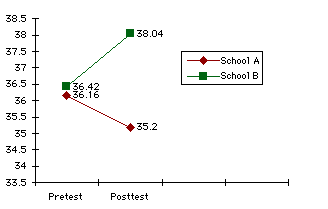
The difference in total attitude
value is more striking. Figure 6, below, shows that School A began significantly
higher on the attitude scale than School B, yet finished significantly
lower.
Figure 6. AIP II: Total Attitude
F(1,94)=5.28, p = .02
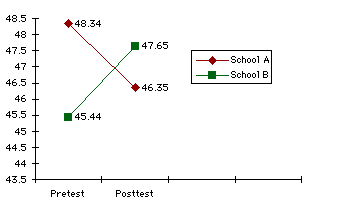
More particularly, School B had
an interaction effect with School A with regard to the total perceived
self-efficacy in art. As shown in Figure 7, below, School A began significantly
higher on the perceived self-efficacy in art scale than School B, yet finished
significantly lower.
Figure 7. AIP II: Total Perceived
Self-Efficacy-Art
F(1,109)=8.78, p < .01 (.0037)
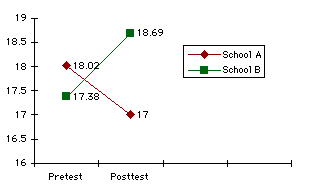
And, significantly for the Arts
Integration Program's theater lessons, all classes in both schools showed
improvement on the perceived self-efficacy in all school subject scores.
Figure 8 below, shows this graphically.
Figure 8. AIP II: Perceived Self-Efficacy-All
Subjects
F(1,108)=152.76, p < .0001
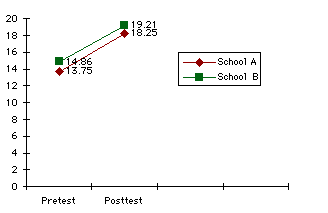
A closer examination of the individual
questions in this instrument showed a strong teacher effect consistently
within each school. This effect may account for the interaction effect
noted above. Figure 9 below, shows that one teacher in each school stood
out, one on each end of the scale. Question 29 ("When its time for theatre,
I feel . . .") showed a strong interaction.
It should be noted that the children
in classes 2 and 3 did not manifest their feelings about theatre in the
classroom. In fact, their performances were among the most skillful. Class
2, in particular, benefited from their teacher's professional stage experience,
and were perhaps more challenged by it. See Figure 9, below.
Figure 9. AIP II: Question 29 "When
it's time for theatre, I feel . . . ?"
F(5,104)=4.77, p = .0006
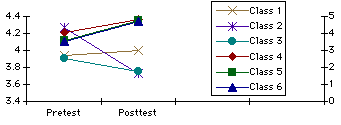
Linguistic Domain
Two items on the questionnaire were
designed to elicit a word list related to the arts. As described above,
question one asked for an open-ended definition of the arts. The last question
was part of a brainstorming process in which students were asked why it
is important to learn about the arts. Student responses to the first question
on the questionnaire, (What are the arts?) showed changes reflecting their
experiences during the year and their individual development. Many went
from a conception of art in school as an activity that they enjoyed, to
broader definitions that encompassed performance, cooperation, literacy,
and learning. The following examples from student responses show some of
these changes. (Student spelling has been corrected)
Student
|
Pretest
|
Posttest
|
#219
|
"It is a project and it
is fun."
|
". . .where you draw and
paint."
|
#124
|
"Drawing, Painting, Coloring,
Making
things."
|
"Drama, acting, Dancing,
Drawing,
Writing."
|
#315
|
"People who can paint or
draw good
pictures."
|
"Theatre, and when you
dance."
|
#504
|
"Tracing, coloring, cubism
. . ."
|
"Mime, color, working together."
|
Some students learned that not just
what 'famous people' did, but also what they did, was part of the arts.
For example:
Student
|
Pretest
|
Posttest
|
#316
|
"People who can paint or
draw good
pictures."
|
"Theater, and when you
dance."
|
#326
|
"Famous people who paint
beautiful
pictures and get a lot of money."
|
"Theatre and painting."
|
#419
|
"Somebody who writes good,
or builds
things, or makes paper, . . ."
|
"It's something you can
draw,
a picture."
|
Many of the posttest responses
to this question, when compared to the pretests, show results of participation
in the Arts Integration Program theatre lessons.
Student
|
Pretest
|
Posttest
|
#421
|
"Painting a lot of pictures
and putting
them in a museum."
|
"Your voice, arms, legs,
movements.
Your body moving is the arts."
|
#513
|
"There are many kinds of
them."
|
"Using you whole body.
It's fun to use mime, use your voice."
|
#302
|
"It is a fun class. You
make things and
you learn how to build things."
|
"It is the theatre."
|
Children who completed both the
pre-test and the posttest in this study showed an expanded view of the
arts that included their classroom activities and abilities as well as
cultural icons such as famous painters and paintings. They included more
performance in their definitions. Certainly, they showed that they were
more aware of the theatre arts after completing the year-long program.
The children were very favorable
in their reported perceptions of the arts. Their enjoyment of the arts
started high at the beginning of the year and continued to the end. "Mi
favorita ting in school. Me gusto much el artes [sic]" (#329, Posttest).
The last question on the questionnaire
again involved a brainstorming, or focus group, activity. Students were
asked to brainstorm in small groups some answers to the question "Why is
it important to learn about the arts?" The reasons listed by each group
were presented to the class, and individually the students selected from
the lists those reasons each thought were most important. Students' responses
from all six classes were mostly in the cognitive and affective categories.
They understood the purpose of the arts to be learning, and they liked,
or disliked, doing art. The graph shows that each class had a unique characteristic
distribution among the categories.
The responses were categorized as
in AIP I. Figures 11 and 12 (below) show the results of the brainstorming
activity.
Figure 11. AIP II: Brainstorming
Pretest
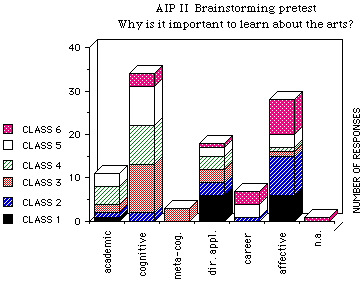
Figure 12. AIP II: Brainstorming
Posttest
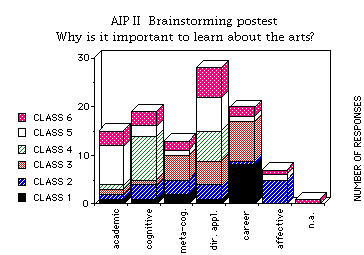
Figure 12, above, shows that the
students' responses on the posttest were more evenly distributed. The patterns
changed over the course of the school year. At the end the students no
longer showed such an affective association for the importance of learning
about the arts. While there were fewer responses in the cognitive category,
there were approximately 50% more responses categorized as meta-cognitive.
And, the number of responses in the career category almost tripled.
Discussion
The teachers were very pleased with
the results of the Arts Integration Program for their classes. Teachers
reported that their students on the whole had increased self-confidence
at the end of the year. They stated that their classes showed a greater
cohesiveness than classes they had before. That is, they and their students
had created a supportive environment where they felt they could take risks.
One teacher noted in her journal
that the class, "felt safe expressing their feelings and thoughts about
issues that they had experienced or were meaningful to them. The more we
did it the more believable and in depth their presentation became."
This feeling of safety that all
the teachers noted enabled the children to benefit from these exercises
in a way that was somewhat indirectly generalizable to other school situations.
Another, third grade, teacher noted that when her class did the next lesson,
Peer Themes, they were able to work directly on real conflict resolution
based on incidents in the school yard at recess.
A third grade teacher wrote in his
journal that "the atmosphere created during theatre dovetailed perfectly
with the idea of personal responsibility we are trying to instill in our
kids." He saw the mediation provided by the theatre lessons very directly.
"The theatre module provides an excellent and non-threatening bridge between
these two worlds."
Teachers all had good reports about
the Mentor-teacher model. The two teams of teachers stated that they were
pleased with the teamwork and mutual support the program offered. Notes
taken during the regular teacher meetings and entries in their journals
show that the model was useful and valuable to the teachers. They reported
at the end of the year that they were comfortable adapting and integrating
the AIP lessons into their teaching. They noticed a change in their classrooms
toward a more supportive atmosphere among the students which they attributed
to the program.
In addition, the principals of both
schools reported their satisfaction with the program. Each made accommodations
during the year for the out-of-classroom time required by the AIP Mentor-teacher
process. They appreciated their time spent as substitute teachers, at the
classroom level, while their teachers took advantage of an opportunity
for professional advancement. The Mentor-teacher process was continued
in both schools the following year, involving the entire school in the
case of School A, and four additional classes with peer cross-age tutors
in School B. Plans are currently to extend the program again in both schools
and to offer it in additional locations.
The Arts Integration Program showed
a definite positive effect on the classroom learning environment. Teachers
overcame their inexperience and nervousness about doing theater and found
new ways of using the arts to mediate learning. Children showed that they
could learn through the arts experience. They showed that they could find
relationships that integrated their theatre arts experiences with their
academic subjects and their real lives. By using theatre to convey their
understanding of text, they also showed that they could master creative
drama techniques which allowed them to transmediate meaning (Harste, 1995).
They showed marked improvement in self-confidence and class cohesion and
they showed this by being able to work collaboratively at new, higher levels.
Perhaps effects are reciprocally
determined in such a program, but the teachers showed improvement that
paralleled the childrens'. Skills and self-confidence grew together. Both
the teachers and the students showed an improved ability to relate to,
appreciate and integrate the work of other visiting artists and artists-in-residence.
The level of teacher collaboration in all areas increased based on working
together on the AIP lessons.
This kind of iterative, collaborative,
and developmental study will have to be repeated often. Programs such as
the Tucson Pima Arts Council's AIP, in many different contexts, and with
many various lessons and activities should be studied in order to best
meet the needs of classroom teachers for stimulating, holistic, and theory-based
learning activities.
This research led the authors to
conclude the following about a successful, long-range program of arts integration:
1. An integration program must link
arts and education so that a teacher can continue presenting the same curriculum.
It should not burden a teacher.
2. All participating teachers need
to want to learn about art integration and should receive adequate training.
3. Teachers have to understand how
art integration can help the classroom community. These same teachers need
to have participated in the planning for the program as co-developers along
with artists, parents, children, arts organizations, and administrators
who support the porgram.
4. Integration programs must be
inclusive of the whole school community and must demonstrate understanding
of how a school works.
5. Integration programs must be
continually assessed and documented and there must be a verifiable consistency
between their claims and their outcomes.
An arts integration program has
the power to turn a classroom into a creative environment full of friendly,
accessible resources where the art of learning and the art of teaching
thrive together. Teachers become empowered to utilize arts in their classrooms.
And, children benefit in an enriched learning environment.
References
Berghoff, Beth (1993). Moving Toward
Aesthetic Literacy in the First Grade. In D.J. Lin & C.K. Kinzer (Eds.)
Examing
Central Issues in Literacy Research, Theory, and Practice. Chicago:National
Reading Conference. pp. 217-226.
Bruner, J. (1991). Acts of meaning.
Cambridge, MA: Harvard University Press.
Gardner, H. (1991). The unschooled
mind. New York: Basic Books.
Eisner, E. (1994). Cognition
and Curriculum Reconsidered. 2nd Edition. NY:Teachers College Press
Moll, L. C. (1991). Vygotsky
in education. New York: Cambridge University Press.
Harste, J., Short, K. & Burke,
C. (1988). Creating classrooms for authors: The reading writing connection.
Portsmouth, NH: Heinemann.
Hartse, J. (1994) Transmediation
in the classroom. Presentation at the Tucson Area Whole Language Conference,
October 28, 1994, Tucson AZ.
Suhor, C. (1992) Semiotics and the
English Language Arts. LanguageArts. V69. March 1992. pp. 228-230.
.............................................................................
For further information contact:
J. David Betts, Ph.D
|
Paul Fisher
|
2821 W. Giaconda Pl.
|
722 W. Vanover Rd.
|
Tucson, AZ 85741
|
Tucson, AZ 85705
|
bettsj@u.arizona.edu
|
pmfisher@u.arizona.edu
|
520 621-4087
|
520 882-5308
|
FAX: Tucson Pima Arts Council 520
624-3001
This study was funded in part by
the Arizona Art Education Research Institute and the Tucson Pima Arts Council.
Many thanks for their support. Thanks also to Dr. William Valmont for his
excellent suggestions.









